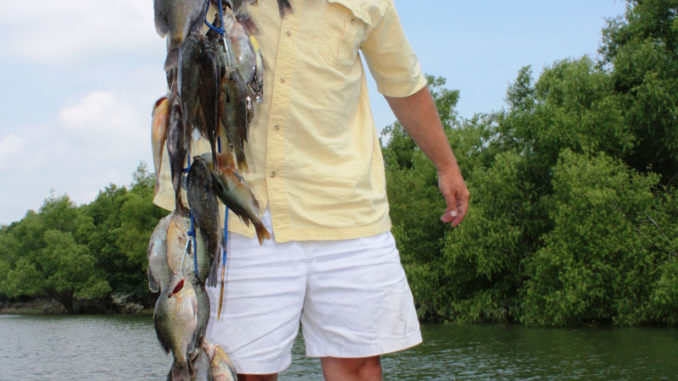
Drift, anchor or fish beds; just about everything will catch Santee River bream in June.
Among the hottest, fastest-paced and most-diverse bream fishing any South Carolina angler could dream of can be found on the Santee River. Fishermen can use one of a handful of different strategies in June: drifting, casting to targets while floating or fishing bream beds. It’s also a hotbed for plenty of different bream species: bluegill, shellcracker redbreast, warmouth and others.
Joe Dennis of Bonneau guides on the Santee River as well as the Cooper River and Lake Moultrie — and for several inshore saltwater species. But during June, he spends much of his time on the Santee River.
“I catch an awesome diversity of fish species, and they can be caught in huge numbers and sizes,” Dennis said. “On most any given day, we catch lots of huge redbreast, beastly bream, super-sized shellcrackers and on some days, a lot of over-sized warmouth,” he said. “The great news is that throughout the month, the rule is that we’re also usually catching limits of these panfish. We can target them individually or enjoy a smorgasbord of fish species, and that’s my favored way.”
Dennis said June is an ideal month because the water has warmed sufficiently to put the various bream all on a great bite, whether they are bedding or not.
“As a rule, we catch most of our redbreast and bream and other panfish species on crickets bumping the bottom in 6 to 10 feet of water,” he said. “I prefer a little current, and we use that to our advantage to find bream just off the shoreline in slightly deeper water. When the fish are not bedding, this is the tried-and-true method for taking them. We don’t lock into any specific depth until we fish a while on any given day. It can vary considerably depending on water level, current and water color.”
Dennis said his basic technique is to drift along with a light spinning rig and fish vertically under the boat.
“We’re using light spinning rigs loaded with 4-pound test line on the panfish,” Dennis said. “We use a 1-ounce bell sinker on the bottom and a short leader a few inches above with a gold No. 2 or No. 4 Eagle Claw hook. We do occasionally catch some catfish as well drifting, and that adds even more diversity.”
When he’s drifting, Dennis said he will typically find pockets of larger fish, and when he does, he’ll re-drift those areas.
“The bigger fish seem to hold together, and there’s a constant series of depth changes as a fisherman drifts along the river,” he said. “Often, the bigger fish are in a slight depression, but sometimes it’s just along a stretch of water where the bottom substrate is a hard sand or gravel. But whatever the reason, an area of bigger fish will cause me to quickly drift back over the area again.”
Dennis generally begins each day drifting so he can cover more area and figure the best course of action.
“On any given day in June and even through the summer, drift-fishing will produce plenty of fish,” he said. “But also I can get a feel if the fish are really stacked up in certain areas, and that can change daily based on current flow as well as water color and even the with bright or cloudy skies. Cloudy days tend to make the fish move shallower, and they also tend to scatter more. On sunny days, the fish will often target a specific area where the water color, depth and light penetration create favorable habitat. The best way for me to calculate that is to drift a while and catch some fish.
“While drift-fishing, I don’t switch to anchor-fishing often, but there are times when I re-drift an area and the action is so good in a localized spot, I’ll move just far enough away to not disturb the fish and anchor,” he said.
Danny Tracy, also from Bonneau, is also a confirmed “Santee River rat.” He loves fishing for all the river’s different bream species in different ways.
“The size and number of fish has to be pretty special to stop and anchor-fish, but when it’s right, it’s the best way to catch fish,” Tracy said. “Drifting is a great way to consistently catch large fish, but when I hit a big concentration of large fish in a small stretch of water, it’s time to anchor.
“I will either cast from the anchored position and tightline with the bell-sinker rig on the bottom or I’ll rig a float with split-shot and hook if it’s not very deep where the fish are holding,” Tracy said. “Sometimes, the float rig will work best if fish are scattered over a target area, because I can cast it above the target and let it drift right over the area the fish are stacked up. But if the current isn’t strong, I can also very effectively use the tightline rig to target a single, specific spot and get bites as fast as the rig sinks to the bottom. When the action slows a bit, we simply pull the anchor and resume drift-fishing.”
Tracy said there are areas of the river where the fishing from an anchored position is best: small pockets or indentations of the shoreline and areas where creeks enter the river. Those are spots where fish will stack up because of the change in current flow.
“In areas where creeks enter the river or small pockets just off the channel where there’s a deeper hole, I’ll anchor and cast to the target,” Tracy said. “Typically, this will be an obvious area, and to properly fish it, the anchored position is best. Usually I’ll cast rigs with floats to the area but again, the tightline rig can work, especially if there’s little or no current or there’s an eddy in the mouth of the creek.”
Dennis said another reason to anchor and fish is when bream are bedding.
“The bedding fish will usually be caught around the week before the full moon in June, but it can happen to some extent most anytime,’ he said. “I look for isolated pockets where the current is slack such as small coves or other shallow areas where the fish can get out of the current to bed. I will anchor and cast crickets under a small, cork float to the bedding areas. I’ll keep checking an area by moving my bait around until I zero in on the bed. If I don’t work it too hard, a bed can produce many additional fish over a period of several days. Once I learn where several places like this are each year, the potential for lots of big, bedding fish increasea even more. If they’re not being caught by drifting, we’ll get them on the beds.”
Dennis said that moving around and trying different types of water is one of the keys to success.
“One day, I’ll hit the fish good in a certain area and the action may hold up for a day or two,” he said. “But then as water conditions change, even just a little bit of warming water or a cool rain dropping temperatures will move the fish, and I’ll need to move to new areas. That’s part of the fun for me, looking for the fish, hunting them down and then catching them in big sizes and numbers.”
Tracy and Dennis said they look for specific features when hunting bream on the river. Dennis said that one of the signals is the vegetative growth on the shoreline that helps him find the right bottom substrate and depth.
“Fishermen know it’s what’s under the water that counts in terms of drops and deeper or shallower water, but the vegetation growing along the shoreline will often help clue me in about what’s under the water. I’ve found that hard bottoms are often best for the big bream. Also, when I see willows growing along the shoreline, I can usually move out a bit from that cover into a few feet of water and expect to catch bream. Not only is the bottom substrate right, but the rate of fall of the bottom is also about right to hold bream in good numbers. Gravel or rock bottom areas are often good and even around areas where there are some large visible rocks, especially where the river widens into larger pools, can be excellent.
Both anglers said this sensational bream fishing for multiple species will usually continue to be excellent throughout June and the summer.
“The next few weeks will provide the most consistent action on the largest fish of the entire year,” Dennis said. “That’s the reason I’ll spend a lot of June right here on the Santee River.”
DESTINATION INFORMATION
HOW TO GET THERE — Fishermen can use several public ramps to access the Santee River, including the Wilson Landing just below the Wilson Dam on Lake Marion; a landing at the US 52 bridge, Arrowhead Resort near St. Stephens and a landing at the US 17 bridge near Jamestown.
WHEN TO GO — June is prime time because the river warms later than the shallow waters on the Santee Cooper lakes, and the current flows also helps with a later burst of action. The June water temperature is ideal for bream, redbreast and shellcrackers. Good fishing continues through the summer, but June is tops.
BEST TECHNIQUES —Fish shallow during the early morning and then move deeper during the day. Bright days are often best, but on cloudy days, fish will often move to the shallows but be more scattered. Drift fishing in 4 to 10 feet of water with crickets or red worms is the No. 1 technique to take bream. When you hit a hot spot, re-drift the area until the action slows then find another hot spot — or finish and leave with your limits.
FISHING INFO/GUIDES — Joe Dennis, 843-245-3762. See also Guides and Charters in Classifieds.
ACCOMMODATIONS — Berkeley County Chamber of Commerce, Moncks Corner, 843-761-8238, www.berkeleysc.org; Charleston Area Convention and Visitors Bureau, www.charlestoncvb.com; South Carolina Association of Visitor Bureaus, www.discoversouthcarolina.com.
MAPS — Delorme’s South Carolina Atlas and Gazetteer, 800-581-5105, www.delorme.com; Fishing Hotspots, 800- ALLMAPS, www.fishinghotspots.com; Kingfisher Maps, 800-326-0257, www.kfmaps.com.

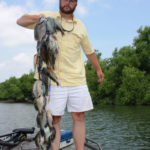
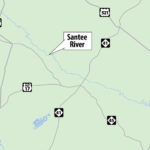
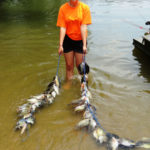
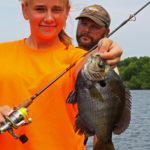




Be the first to comment